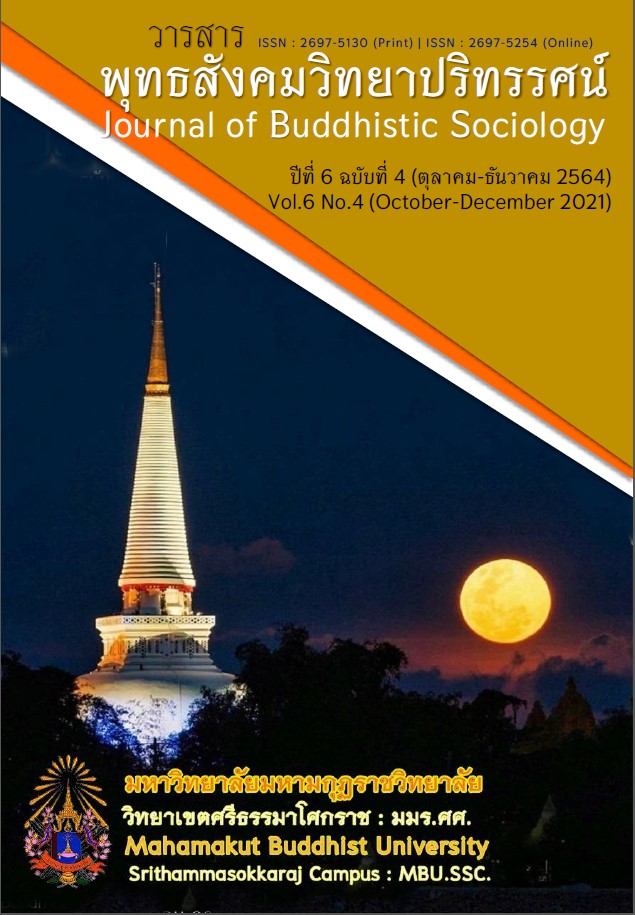THE EFFECTS OF SQ3R TECHNIQUE TO DEVELOP READING ABILITY OF MATHAYOMSUKSA 3 STUDENTS
Main Article Content
Abstract
The purposes of this study were 1) to study and compare English reading ability using SQ3R technique of Mathayomsuksa 3 students before and after the instruction, and 2X to study students’ attitude towards teaching English reading ability using SQ3R technique.
The sample consisted of 23 students of Mathayomsuksa 3 students at Nongnakam Wittayakom School in the second semester of the academic year 2020. They were selected by purposive selection. The design of this research was a one group pretest-posttest design. The research instruments included 10 lesson plans, an English reading ability for comprehension test, and an attitude questionnaire.
The findings were as follows;
1. The students’ pretest and posttest mean scores on English reading ability for comprehension were 6.17 or 20.58 percent and 21.22 or 72.72 percent respectively. The posttest score was higher than the criteria of 70 percent and it was significantly higher than that of the pretest at the .01 level.
2. The students’ attitude towards teaching English reading ability for comprehension using SQ3R technique was at a good level.
Article Details
References
กระทรวงศึกษาธิการ. (2551). หลักสูตรแกนกลางการศึกษาขั้นพื้นฐาน พุทธศักราช 2551. กรุงเทพมหานคร: โรงพิมพ์องค์การรับส่งสินค้าและพัสดุภัณฑ์.
______. (2552). หลักสูตรแกนกลางการศึกษาขั้นพื้นฐาน พุทธศักราช 2551. กรุงเทพมหานคร: โรงพิมพ์ชุมนุมสหกรณ์การเกษตรแห่งประเทศไทย.
คัชรินทร์ มหาวงศ์. (2541). การสร้างแบบวัดเจตคติต่อวิชาคณิตศาสตร์ที่วิเคราะห์โดยวิธีพาเชียลเครดิตโมเดลสำหรับนักเรียนชั้นประถมศึกษาปีที่ 5. ใน วิทยานิพนธ์ปริญญาศึกษาศาสตรมหาบัณฑิต สาขาวิชาการวัดและประเมินผล. มหาวิทยาลัยเชียงใหม่.
ล้วน สายยศ และอังคณา สายยศ. (2543). การวัดด้านจิตพิสัย. กรุงเทพมหานคร: สุวีริยาสาส์น.
วันเพ็ญ วัฒฐานะ. (2557). การจัดการเรียนรู้โดยใช้เทคนิคการอ่านแบบ SQ3R เพื่อพัฒนาความเข้าใจในการอ่านและศึกษาพฤติกรรมการอ่านภาษาอังกฤษของนักเรียน ชั้นประถมศึกษาปีที่ 6. ใน วิทยานิพนธ์ครุศาสตรมหาบัณฑิต สาขาหลักสูตรและการสอน. มหาวิทยาลัยบูรพา.
สถาบันส่งเสริมการสอนวิทยาศาสตร์และเทคโนโลยี (PISA). (2562). เมื่อการอ่านกลับมาเป็นการประเมินหลักใน PISA 2018. เรียกใช้เมื่อ 5 สิงหาคม 2563 จาก https://pisathailand.ipst.ac.th/issue-2019-44/
สมุทร เซ็นเชาวนิช. (2549). เทคนิคการอ่านภาษาอังกฤษเพื่อความเข้าใจ. กรุงเทพมหานคร: สำนักพิมพ์มหาวิทยาลัยธรรมศาสตร์.
สุมิตรา อังวัฒนกุล. (2540). วิธีสอนภาษาอังกฤษเป็นภาษาต่างประเทศ (พิมพ์ครั้งที่ 4). กรุงเทพมหานคร: จุฬาลงกรณ์มหาวิทยาลัย.
Biringkanee, A. (2018). The use of SQ3R Technique in improving students’ reading comprehension. ELS-Journal on Interdisciplinary Studies on Humanities, 1(2), 218-225.
Brown, A. L. & Palincsar, A.S. (1982). Inducing strategic learning from text by means of informed, self-control training. Topics in Learning and Learning Disabilities, 2(1), 1-17.
Kusumayanthi, S. & Maulidi, S.M. (2019). The implementation of SQ3R Technique in teaching reading comprehension. The Journal of English Language Teaching, Literature, and Applied Linguistics (JELA), 1(2), 74-80.
Likert, R. (1932). A Technique for the Measurement of Attitudes. Archives of Psychology.
Robinson & Francis Pleasant. (1982). Effective Study (6 ed.). New York: Harper & Row.
Thiede, K. W. et al. (2015). Developing Reading Comprehension through Metacognitive Strategies: A Review of Previous Studies. English Language Teaching, 8(8), 181-186.
Widiawati, T. et al. (2020). Improving the students’reading skill through SQ3R technique in MTS Al-Kheriyah. Journal of Language, Literature, and Linguistics, 1(1), 71-78.


